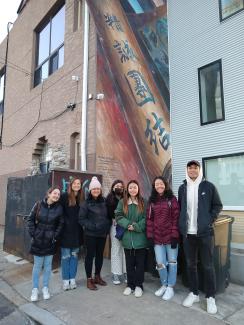
Not many Penn students have to give a presentation on a narrow street in Philadelphia’s Chinatown, trying to keep listeners’ attention as shoppers amble by chatting, scooters rev engines at stop lights, and anxious commuters honk at slow traffic. But students in history Ph.D. candidate Sarah Yu’s Chinese diasporas course did just that this spring, when they spent a day as Chinatown tour guides.
It was all part of Yu’s seminar, The Chinese Diaspora(s): Culture, Conflict, & Cuisine, 19th century to the Present, where students not only became tour guides but also podcasters, learning about migration and Chinese overseas communities, all while honing their public speaking skills with the help of Penn’s Communication Within the Curriculum program (CWIC).
“Having had Chinese Americans in the news so often in the past couple of years—because of COVID, because of the rise in hate crimes and even the lawsuits against Harvard—it has renewed ideas about what Chinese migration has meant for this country and others,” Yu says. “It’s a good time to do a course like this, and when the opportunity to work with CWIC came up, I thought, Why not make the course public-speaking oriented?”
CWIC is a program within the School of Arts & Sciences that connects undergraduates trained in public speaking with others across the school in need of assistance, from a public speaking-intensive undergrad course to assistance for graduate students in presenting research. The Chinese diasporas class connected with CWIC adviser Rodrigo Veiga da Cunha, a sophomore majoring in political science and economics from outside Porto Alegre, Brazil.
He worked with Yu’s class of six students, first in pairs that were giving the tours of Chinatown together, then individually to help them prepare to interview their podcast subjects.
While mostly focused on the Chinese in the United States, the seminar also drew comparative examples from Australia, Britain, and Southeast Asia, among other localities to which the Chinese migrated. Even though the current day “Chinese diaspora” is made up of diverse linguistic, ethnic, and class groups, its national place of origin was a unifying identifying feature, both internally and externally, throughout the history of Chinese migration, Yu says.
The class stops before it gets to contemporary history and way before the COVID pandemic, she says, but that is also because Yu wanted to give students leeway in their final projects, which consisted of interviewing people who work on broadly-defined Chinese migrant welfare for a podcast.
“They could be artists, they could be lawyers, legal advocates, journalists, historians,” says Yu. “A lot of the interview subjects have talked about COVID. A lot of them have really thought about how we can understand today’s treatment of Chinese migrants with this historical perspective.”
The class headed to Chinatown in March after a unit on Chinatowns around the world, looking at similarities, differences, aesthetic elements, and what the designation of “Chinatown” means for business opportunities and smaller municipal governments. Three groups of two students took turns showing classmates and special guests around the community for 20 minutes each.
“There are a lot of things to consider in Chinatown. There’s noise, being stuck on a little street in Center City with people driving by. It’s not what we usually think of when we think about public speaking,” Yu says. “There’s always something that goes a little bit differently, and the students really brought a lot of energy. It was really fun to see their personalities come out when they were doing the tours.”
The oral assignments got the students thinking about how they could be better communicators, Yu says. “Those are going to be skills that they can take with them anywhere they go. These presentation skills are transferable skills.”
Olivia Loo, a junior majoring in philosophy, politics, and economics and in East Asian languages with a focus on Chinese, says she first looked into the class because it was relevant to her Chinese major, but the fact that it was also a critical speaking seminar sealed the deal.
“I’ve never taken a class where a lot of the assignments are based on speaking as opposed to writing or reading or tests,” Loo says. “It was a great opportunity to take a new format of class and was also in alignment with what I'm interested in studying. It’s really fun to study and learn in a different way.”
Read the entire story HERE
